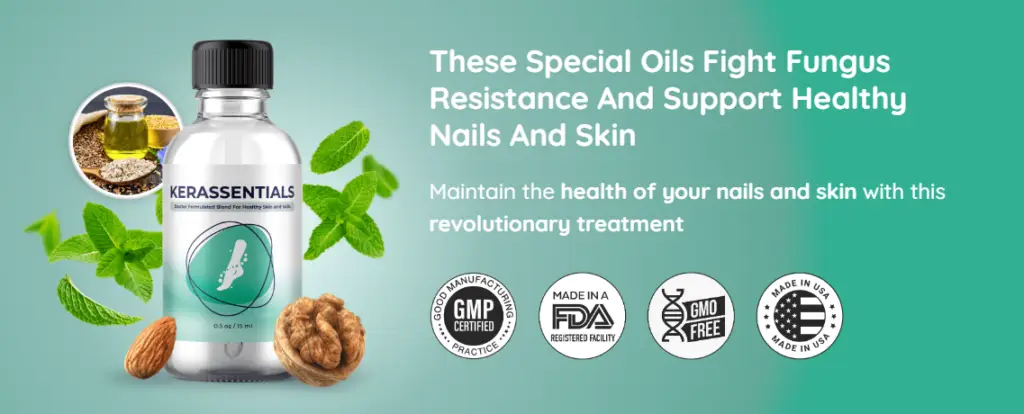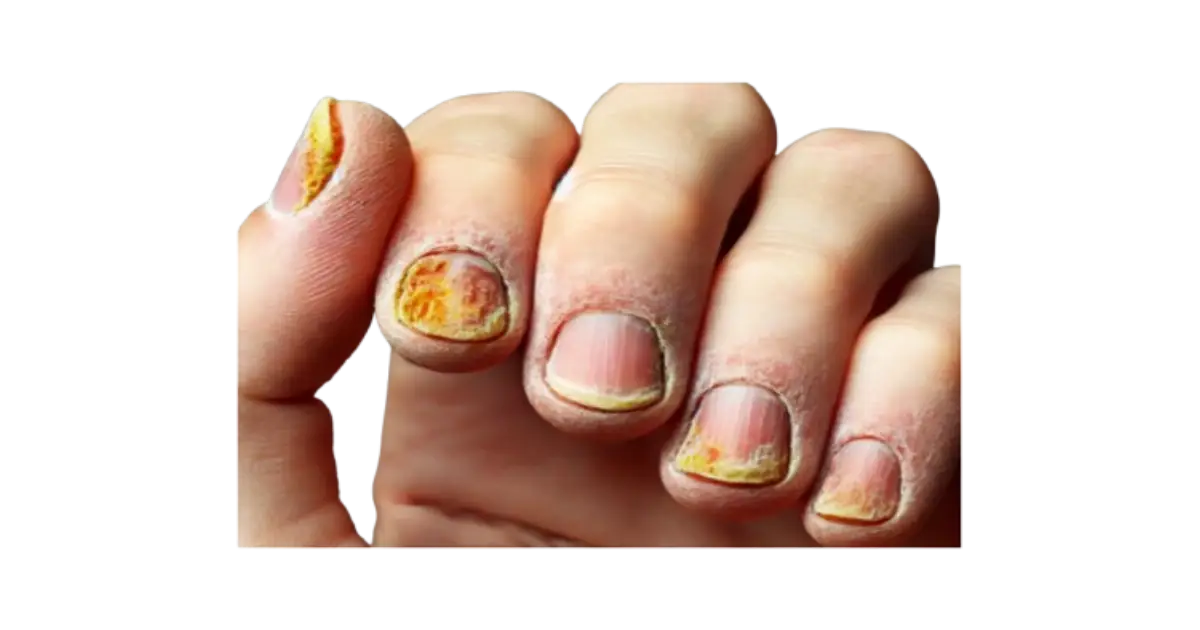Have you ever seen your fingernails change color or become brittle and thick? It could be an infection you’re dealing with if so. There are many Types of Fingernail fungus, also referred to as onychomycosis. Is quite a problem that can impact about anyone out there! Although it may appear to be a matter of appearance, at glance; leaving nail fungus untreated can actually result in discomfort or pain and might even lead to more serious issues by spreading to other nails or skin areas.
Welcome to this article where I’ll walk you through the kinds of fingernail fungus infections and their underlying causes well, as ways to prevent or remedy this condition—whether you’re currently grappling with nail fungus or simply seeking more information, on the topic.
Understanding The Different Types Of Fingernail Fungus (Onychomycosis)
What is Fingernail Fungus?
Having fungus in your fingernails happens when fungi get into your nails due, to a cut or crack or if the nail or surrounding skin is weak in some way.It’s quite common to get these infections in places that’re moist like showers or locker rooms where fungus can thrive as it prefers warm and damp environments. Your nails are no different, in this regard.
When a fungus infects the nail bed. Takes root in severe cases this can lead to thickened and discolored nails that become brittle or may even detach from the nail bed entirely causing discomfort and hindering everyday activities such, as nail trimming or wearing shoes.
.
Symptoms of Fingernail Fungus
How to Recognize a Fungal Infection
How can you tell if you have an infection, on your nail bed or toes? Initial indications involve a shift in hue to white or shades of yellow and brown. Your nail may start to show signs of fragility or splitting easily. Could appear thicker, than its state.
- Discoloration: The infected nail may develop a yellowish, whitish, or brownish tint.
- Thickening: Fungal infections often cause the nail to thicken, making it harder to trim.
- Brittleness: Affected nails can become fragile and start to crumble.
- Separation: In severe cases, the nail may separate from the nail bed.
When to Consult a Healthcare Provider
Many folks try to cure nail fungus using home remedies but there comes a time when its best to seek assistance instead.If your nail starts hurting or detaching from the nail bed or you don’t see any progress, over the counter(OTC) treatments it might be a sign to consult a doctor. It’s crucial for people, with diabetes or weakened immune systems to be extra careful as untreated fungal infections can cause health issues.
Types of Fingernail Fungus
There are many different types of fingernail fungus, and understanding which one you have can help you select the most effective treatment.
1. Distal Subungual Onychomycosis
The most common type of nail fungus typically begins at the tip of the nail. Progresses, towards the cuticle area with manifestations such, as yellowing of the nail bed and thickening or potential crumbling along the edges.
2. White Superficial Onychomycosis
Unlike distal subungual onychomycosis, this type affects the surface of the nail. White patches appear on the nail plate, causing the nail to become soft and crumbly. This type of infection can be easier to treat if caught early.
3. Proximal Subungual Onychomycosis
This particular nail fungus usually begins close, to the cuticle. Then it progresses towards the edge of the nail, known as subungual onychomycosis. This is more frequently observed in people, with weakened immune systems and might suggest an undisclosed health issue.
4. Candidal Onychomycosis
Individuals are prone, to developing this infection due to a yeast called Candida when their hands are frequently wet or exposed to water for periods of time. This is common among healthcare workers and chefs alike. The affected nail usually shows signs of discoloration along, with swelling and pain.


What Causes The Different Types Of Fingernail Fungus?
Nail fungus is triggered by types of fungi; the most frequent being dermatophytes. This is a type of fungus that thrives in keratin found in nails and typically enters through small cuts or cracks, around the nail or nail bed.
Frequent hand immersion, in water can lead to fingernail fungus caused by Candida. This is commonly seen in individuals, like healthcare workers and those who work as dishwashers or cleaners.
Who is at Risk of Developing Fingernail Fungus?
Some specific underlying factors can raise the chances of getting nail fungus so knowing who is more susceptible can aid in preventing and spotting it on.
1. Age and Weakened Immune Systems
As people get older and their nails grow slower and become more brittle over time the risk of nail fungus increases since fungi can easily penetrate weakened nails. In addition older adults may experience reduced blood circulation, which can weaken the bodys ability to combat infections naturally.
Individuals, with compromised systems. Like those receiving chemotherapy or using medications are at a higher risk of developing fungal infections as well.. The weakened defense system of the body makes it challenging to combat fungal invaders effectively resulting in fungal infections persisting longer, than usual.
2. Nail Damage and Moisture Exposure
Regular contact, with moisture like when washing your hands or being immersed in water raises the likelihood of contracting an infection. Furthermore nail salons that fail to sterilize their equipment can cause harm to nails and facilitate the spread of fungus.
If your nails get long and you keep cutting them short often causes damage, to them that can let fungus in easily. Especially for those who wear tight shoes or use nail polish a lot because the nail bed can weaken due, to moisture and lack of air flow.
3. Diabetes and Other Underlying Health Conditions
Individuals who have diabetes face an increased susceptibility to nail fungus because of the bodys compromised circulation, to the extremities which makes them more prone to infections and slower in recovery processes.. For people with diabetes minor infections can escalate into health issues; therefore it is crucial for those, with diabetes to stay diligent in taking care of their nails.
How to Prevent Getting The Many Types Of Fingernail Fungus
Preventing nail fungus largely comes down to keeping your nails clean and dry while avoiding common fungal environments.
1. Keeping Nails Clean and Dry
One easy method to avoid infections is, by maintaining care of your nails by washing your hands and feet regularly. Make sure they are completely dry after being wet or exposed to damp environments such, as inside shoes or gloves where fungi thrive.
2. Avoid Sharing Nail Care Tools
Make sure not to share nail care items, like nail clippers and files with others to prevent the spread of fungi that can live there easily from person, to person. In nail salon make sure all tools are properly cleaned before use to avoid any chance of contamination!
3. Wearing Moisture-Wicking Socks and Gloves
For those who frequently work in wet environments, consider wearing moisture-wicking socks or gloves. These specialized fabrics help to keep moisture away from the skin and nails, reducing the risk of fungal infections.
Treatment Options for Fingernail Fungus
If you happen to get an infection there’s no reason to worry much about it as there are various treatment choices accessible dependingon how serious your situation is.
1. Over-the-Counter Treatments
Many people start their treatment using OTC) medications such, as antifungal creams and ointments or nail polishes specifically designed for nails affected by fungus infections These remedies can prove to be successful, in addressing minor instances of nail fungus infection especially when detected early. These treatments function by impeding the growth of the fungus and aiding in the restoration of the nail to a condition.
Over the counter treatments might require some patience before you notice any changes and certain infections might not completely improve with these methods. If you don’t see any progress after using them for a weeks don’t hesitate to explore more advanced treatment options.
2. Prescription Medications
In cases of infections physicians commonly recommend oral antifungal drugs such, as terbinafine or itraconazole. These medications aid in eradicating the infection by acting and eliminating the fungus from within. Oral antifungals can be very effective. However they also carry the risk of causing side effects. They can cause liver damage or skin reactions which’s why they are typically prescribed for periods of time..
Some Physicians might recommend treatments such, as ciclopirox or efinaconazole which are directly applied to the affected nail. It can be combined with antifungal medications for a more thorough approach, to treatment.
3. Laser Treatment and Other Advanced Options
Another effective method, for managing nail fungus is laser therapy.Treatment involves directing the laser at the area to eradicate the fungus while protecting the surrounding tissue, from harm. This approach shows benefits but, it often requires many sessions and tends to be pricier compared to conventional medications. .

Home Remedies for Different Types Of Fingernail Fungus
If you’re looking for solutions to deal with nail fungus issues at home, there are many options.
1. Tea Tree Oil
Tea tree oil has been known for its properties and has a long history of being used to address skin and nail infections. To apply it effectively; put a drops of tea tree oil on the infected nail ensuring it goes into the nail bed. Consistent use of this remedy might help in decreasing growth; however it could take a few months to notice any progress.
2. Vinegar Soaks
A commonly used DIY solution involves soaking your nails in a mixture of vinegar and water for 20 minutes each day to create an environment that hinders fungal growth effectively but requires regular and prolonged application similar, to tea tree oil.
3. Garlic
Garlic is well-known for its antifungal properties due to the presence of allicin, a compound that helps to inhibit fungal growth. Crushed garlic can be applied directly to the affected area or consumed as part of your diet.
When to See a Doctor
Knowing when it’s time to seek advice, from a healthcare professional for an infection is crucial – particularly if it doesn’t improve with home remedies or medications without a prescription.
1. Persistent Symptoms or Spreading Infection
If your nail infection doesn’t show signs of getting better after a weeks of treatment or seems to be worsening in any way it’s a good idea to schedule an appointment, with a doctor, for further evaluation and care. Seeking help can help stop the infection from spreading to nails or areas of your skin.
2. Risk of Complications for High-Risk Individuals
If you have diabetes or circulation problems or a weakened immune system and you think you might have a nail fungus infection it’s important to consult a healthcare professional as possible. If left untreated fungus infections can result in complications such, as ulcers or bacterial infections.
Nail Fungus and Its Impact on Daily Life
Having nail fungus may appear insignificant issue initially but it could significantly affect your life if left untreated. The visual aspect of the infection can make individuals feel self conscious, about revealing their hands or feet in public.
Severe nail fungus can result in pain or discomfort while walking or wearing shoes; this can make day, to day activities challenging to carry out without any difficulties. The condition left unattended may also spread to nails. Cause lasting harm, in the long run.
Conclusion
Fingernail fungus is pretty common. It doesn’t mean you’re stuck, with it forever. If you spot the signs early and know the variations of nail fungus there you can handle it by taking the actions to heal and stop it from spreading more. Whether you choose to use store bought treatments or get prescriptions or go with options just remember to stay calm and stick to your treatment routine consistently.
Caring for your nails is important not, for their appearance but for the health and wellness of your nails overall! By practicing hygiene habits and avoiding environments with a risk of infection you can lower the likelihood of developing a fungal infection and keep your nails healthy and free, from fungus.
FAQs
- How long does it take to treat nail fungus?
Treatment can take several weeks to months, depending on the severity of the infection and the type of treatment used. - Can nail fungus be prevented?
Yes, by keeping your nails clean and dry, wearing protective shoes in public areas, and avoiding sharing personal items like nail clippers, you can prevent nail fungus. - Are home remedies effective for nail fungus?
Home remedies like tea tree oil or vinegar soaks can be effective for mild cases of nail fungus, but persistent infections may require professional treatment. - Can nail fungus return after treatment?
Yes, nail fungus can recur if proper hygiene and preventive measures aren’t followed. Recurrence is more common in individuals with underlying health conditions or frequent moisture exposure. - What should I do if the infection spreads to other nails?
If the infection spreads, it’s essential to consult a doctor. More aggressive treatment options, such as oral antifungals or laser therapy, may be necessary to prevent further spreading.


